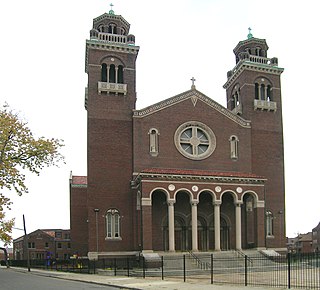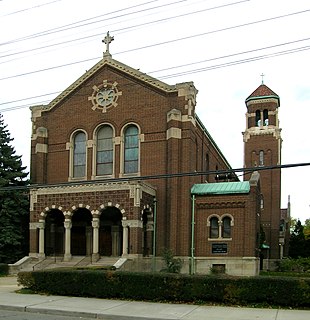
Mexicantown is a community in Southwest Detroit, Michigan.

Ste. Anne de Détroit (Sainte-Anne-de-Détroit) was founded July 26, 1701 by French colonists in New France, and is the second-oldest continuously operating Roman Catholic parish in the United States. The current Gothic Revival cathedral-styled church, built in 1886, is located at 1000 Ste. Anne Street in Detroit, Michigan, in the Richard-Hubbard neighborhood, near the Ambassador Bridge, and the Michigan Central Station. At one time it was the seat of a diocese that included French territory in Ontario, Canada south of the Detroit River.

Holy Redeemer High School was a Roman Catholic secondary school located in Southwest Detroit, at the corner of Junction and Vernor streets, near the Ambassador Bridge to Canada. It was overseen by the Archdiocese of Detroit.

Old St. Mary's Church is a Roman Catholic Church in Cincinnati's historic Over-The-Rhine neighborhood. It is the oldest continually used house of worship in Cincinnati.

The architecture of metropolitan Detroit continues to attract the attention of architects and preservationists alike. With one of the world's recognizable skylines, Detroit's waterfront panorama shows a variety of architectural styles. The city's historic Art Deco skyscrapers blend with the post-modern neogothic spires of One Detroit Center. Together with the Renaissance Center, they form the city's distinctive skyline.

This is a list of the National Register of Historic Places listings in Detroit, Michigan.

The West Canfield Historic District is a neighborhood historic district located primarily on Canfield Avenue between Second and Third Streets in Detroit, Michigan. A boundary increase enlarged the district to include buildings on Third Avenue between Canfield and Calumet. The district was designated a Michigan State Historic Site in 1970 and listed on the National Register of Historic Places in 1971; a boundary increase was added in 1997. The revitalized 1870s era neighborhood is one of the residential areas surrounding the city's Cultural Center Historic District in Midtown. Nearby, East Canfield Avenue leads to the Detroit Medical Center complex, the Romanesque Revival styled St. Josaphat's Catholic Church, and the Gothic revival styled Sweetest Heart of Mary Catholic Church.

St. Boniface Roman Catholic Church was a Roman Catholic church located at 2356 Vermont Avenue in Detroit, Michigan. It was also known as St. Boniface-St. Vincent Roman Catholic Church. The church was designated a Michigan State Historic Site in 1983 and listed on the National Register of Historic Places in 1989, but was subsequently demolished.

West Vernor–Junction Historic District is a commercial historic district located along West Vernor Highway between Lansing and Cavalry in Detroit, Michigan. The district includes 160 acres (0.65 km2) and 44 buildings. The district was listed on the National Register of Historic Places in 2002.

The West Vernor–Lawndale Historic District is a two-block commercial historic district located along West Vernor Highway between Cabot and Ferris Streets in Detroit, Michigan. The district includes 30 acres (120,000 m2) and 10 buildings. It was listed on the National Register of Historic Places in 2002.

The St. Theresa of Avila Roman Catholic Church is a church located at 8666 Quincy Street in Detroit, Michigan. It was listed on the National Register of Historic Places in 1989.

St. Charles Borromeo Roman Catholic Church is a church located at the corner of Baldwin Avenue and St. Paul Avenue in Detroit, Michigan. The church address is 1515 Baldwin Street; ancillary buildings are located at 1491 Baldwin Street (Rectory) and 1480 Townsend Street. The complex was listed on the National Register of Historic Places in 1989.

The St. Stanislaus Bishop and Martyr Roman Catholic Church is a church located at 5818 Dubois Street in Detroit, Michigan. The church was listed on the National Register of Historic Places in 1989.

St. Thomas the Apostle Catholic Church was a church located at 8363 and 8383 Townsend Avenue in Detroit, Michigan. It was listed on the National Register of Historic Places in 1989, but was subsequently demolished.

The St. Catherine of Siena Roman Catholic Church is a church located at 4151 Seminole Street in Detroit, Michigan. It is now the St. Augustine and St. Monica Roman Catholic Church. The church was listed on the National Register of Historic Places in 1991.

The Most Holy Redeemer Church is located at 1721 Junction Street in Southwest Detroit, Michigan, within the West Vernor-Junction Historic District. The church was once estimated as the largest Roman Catholic parish in North America. West Vernor-Junction Historic District is adjacent to Mexicantown and contains a growing Mexican community and resurgent neighborhoods.

The St. Mary's Church Complex Historic District is a historic district located at the junction of Elm Avenue and North Monroe Street (M-125) in the city of Monroe, Michigan. It was listed as a Michigan Historic Site and added to the National Register of Historic Places on May 6, 1982.

The Saint Paul Catholic Church Complex is located at 157 Lake Shore Rd. in the Detroit suburb of Grosse Pointe Farms, Michigan. The group includes a French Gothic-style church, a Neo-Tudor rectory, a Colonial Revival parish hall, a Neo-Tudor school building, and an Elizabethan Revival convent. The complex was designated a Michigan State Historic Site in 1992 and listed on the National Register of Historic Places in 1994.






























